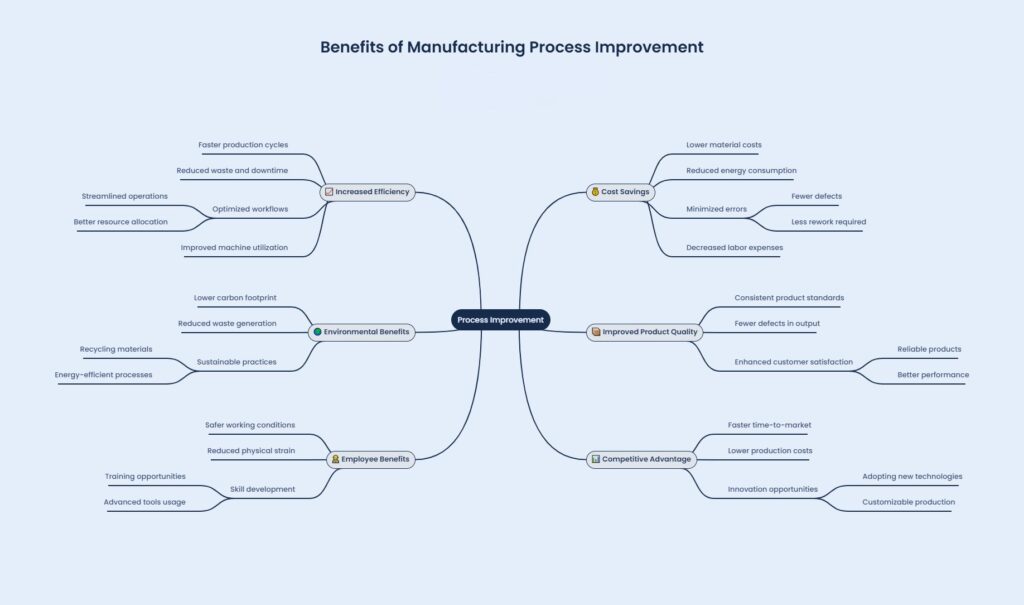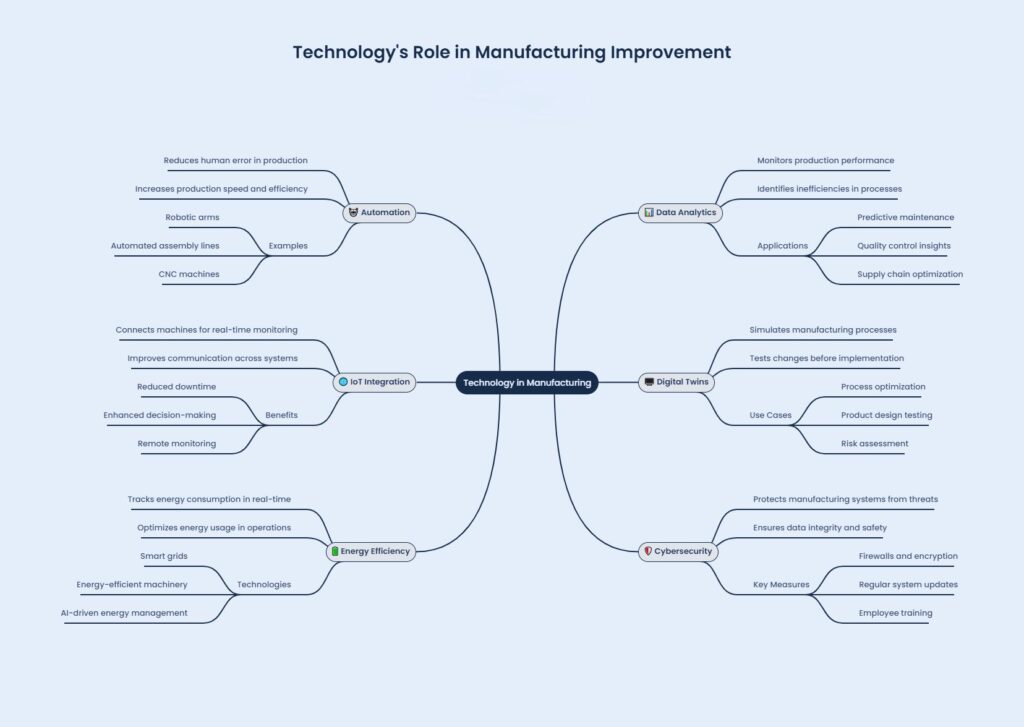Imagine being able to reduce production costs by up to 30% while boosting efficiency and meeting customer demands faster than ever before. Sounds like a dream?
According to a McKinsey report, companies that focus on process optimization can achieve these results and more. In a digital world where time and precision are everything, improving your manufacturing processes isn’t just a smart move, it’s essential.
In this blog, we’ll explore how you can optimize your manufacturing processes, reduce waste, and improve productivity.
What Is Manufacturing Process Improvement?
Manufacturing process improvement refers to strategies and techniques that streamline production processes, enhance quality, reduce waste, and increase efficiency.
By identifying bottlenecks, embracing innovative tools, and implementing proven methodologies like Lean Manufacturing or Six Sigma, businesses can maximize output and minimize inefficiencies.
But why is this so important?
According to Statista, global manufacturing output surpassed $44 trillion in 2024, showing just how massive and competitive this sector is. Staying ahead requires constant evolution and improvement.
The Benefits of Manufacturing Process Improvement

- Increased Productivity Efficient workflows mean your team and machinery are performing at their best. A Deloitte study found that manufacturers who optimize processes see up to 40% increases in productivity.
- Cost Reduction Eliminating inefficiencies helps cut costs. Techniques like Lean Manufacturing focus on waste reduction, leading to significant savings.
- Improved Product Quality Streamlined processes reduce errors, ensuring consistent quality and happier customers.
- Faster Time-to-Market An optimized process shortens production cycles, enabling you to meet market demands quickly.
- Enhanced Employee Morale A smooth operation fosters a more satisfying work environment, boosting employee engagement.
Strategies for Manufacturing Process Improvement
1. Analyze Current Workflows
Start with a thorough analysis of your current processes. Use tools like process mapping to identify bottlenecks, redundancies, or areas of waste. Involve your team in this process to get on-the-ground insights.
Internal Resource: Understanding Workflow Efficiency
2. Embrace Lean Manufacturing Principles
Lean Manufacturing focuses on eliminating waste in seven key areas: overproduction, waiting, transportation, inventory, motion, over-processing, and defects. Companies like Toyota have implemented Lean practices to perfection, saving billions annually. Learn more about Lean Manufacturing from the Lean Enterprise Institute.
3. Implement Automation
Automation can significantly improve efficiency by reducing manual labor and minimizing errors. Technologies like robotics, IoT, and AI are revolutionizing how manufacturers operate. Additionally, integrating an electronic batch record system ensures seamless tracking and documentation of production data, enhancing both compliance and manufacturing efficiency.
Example: A case study by Boston Consulting Group revealed that manufacturers implementing IoT technology saw production efficiency increase by up to 30%.
4. Invest in Employee Training
Your workforce is your greatest asset. Training your employees to work with new technologies and processes ensures smoother transitions and better outcomes. According to LinkedIn’s Workplace Learning Report, companies that invest in employee training see 24% higher profit margins.
5. Monitor and Measure Performance
You can’t improve what you don’t measure. Use KPIs like Overall Equipment Effectiveness (OEE) and First Pass Yield (FPY) to track progress. Regular audits will help you identify what’s working and what’s not. Understanding what a batch manufacturing record is and how it tracks production steps can provide critical insights into efficiency improvements.
6. Adopt Sustainability Practices
Sustainable manufacturing practices not only improve efficiency but also reduce your environmental footprint. For example, GE’s Ecomagination initiative helped them reduce greenhouse gas emissions by 30% while saving $300 million.
7. Leverage Data Analytics
Data-driven decision-making is transforming manufacturing. Use advanced analytics to predict equipment failures, optimize inventory, and streamline operations. Software like Tableau or Power BI can provide actionable insights from complex data sets. Knowing how to make a product more efficient starts with interpreting the right data.
Case Studies: Real-World Examples of Process Improvement
1. Tesla’s Gigafactories
Tesla’s vertically integrated production model combines automation, advanced robotics, and process innovation to achieve unparalleled efficiency. Their Nevada Gigafactory produces batteries at record speed and cost efficiency.
2. Ford’s Lean Transformation
Ford implemented Lean Manufacturing principles to cut production time by 25%, reduce waste, and enhance vehicle quality. This transition turned struggling plants into profit powerhouses.
The Role of Technology in Manufacturing Process Improvement

1. Internet of Things (IoT)
IoT devices provide real-time monitoring of machinery, enabling predictive maintenance and reducing downtime. For instance, Caterpillar uses IoT to monitor equipment health and prevent breakdowns.
2. Artificial Intelligence (AI)
AI-driven solutions optimize production schedules, identify inefficiencies, and improve quality control. McKinsey estimates that AI could add $13 trillion to the global economy by 2030, with manufacturing being a key beneficiary.
3. 3D Printing
Additive manufacturing enables rapid prototyping, reducing production time and costs. Companies like Adidas are leveraging 3D printing for custom footwear, improving both speed and quality.
4. Electronic Batch Record Systems
Implementing an electronic batch record system simplifies compliance and traceability while boosting overall manufacturing efficiency. These systems digitize production records, eliminating manual errors and streamlining audit readiness.
Overcoming Common Challenges in Process Improvement
Let’s discover practical strategies to tackle resistance to change, manage costs, and make data work for you. Overcoming these obstacles is the key to unlocking efficiency and driving continuous growth in your manufacturing processes.
1. Resistance to Change
Solution: Foster a culture of continuous improvement by involving employees in decision-making and providing adequate training.
2. High Initial Costs
Solution: Focus on long-term ROI. Many technologies pay for themselves through increased efficiency and reduced waste.
3. Data Overload
Solution: Use advanced analytics tools to filter and interpret data effectively.
The Future of Manufacturing Process Improvement
The manufacturing industry is evolving rapidly, driven by advancements in technology and changing consumer demands. Future trends include:
- Smart Factories: Fully automated facilities that use AI and IoT for real-time decision-making.
- Sustainable Manufacturing: Emphasis on eco-friendly processes and materials.
- Collaborative Robotics (Cobots): Robots working alongside humans to improve productivity and safety.
By staying ahead of these trends, you can ensure your business remains competitive in the ever-changing landscape.
Final Thoughts
Manufacturing process improvement is not just about cutting costs or increasing output; it’s about building a foundation for sustainable growth and innovation. By implementing the strategies outlined in this guide, you can transform your operations and achieve unparalleled efficiency.
At GMP Pros, we specialize in helping manufacturers like you achieve operational excellence. With years of industry expertise, cutting-edge tools, and a results-driven approach, we deliver tailored solutions to transform your operations.
Take the first step toward unparalleled efficiency. Contact GMP Pros today!
Ready to take the leap? Start today by analyzing your current processes and partnering with experts like GMP Pros to guide you on your journey to excellence.

